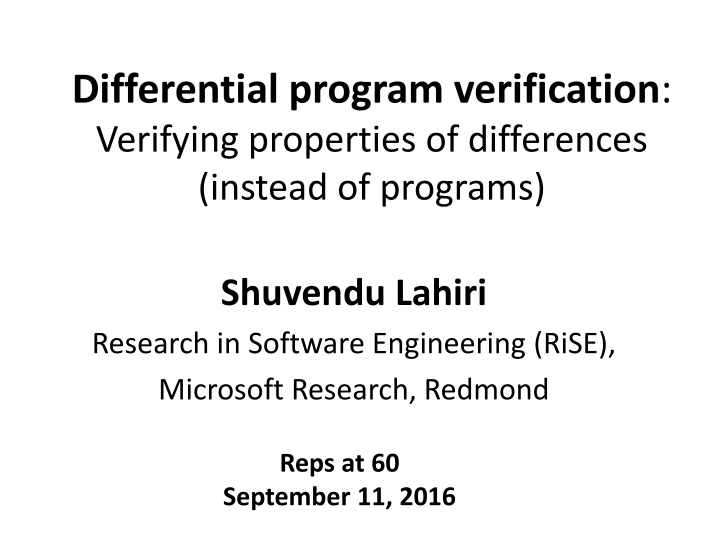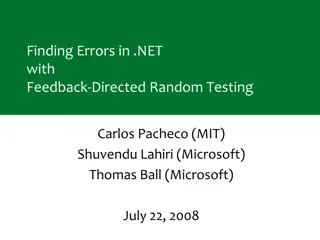
Differential Program Verification: Understanding Differences
Explore the concept of differential program verification, where properties of differences instead of programs are verified. Learn about the motivation, research questions, applications, and ongoing progress in this domain. Discover how differential verification can impact software engineering tasks, analysis, and debugging, and how it leverages program specification and verification advancements.
Download Presentation

Please find below an Image/Link to download the presentation.
The content on the website is provided AS IS for your information and personal use only. It may not be sold, licensed, or shared on other websites without obtaining consent from the author. If you encounter any issues during the download, it is possible that the publisher has removed the file from their server.
You are allowed to download the files provided on this website for personal or commercial use, subject to the condition that they are used lawfully. All files are the property of their respective owners.
The content on the website is provided AS IS for your information and personal use only. It may not be sold, licensed, or shared on other websites without obtaining consent from the author.
E N D
Presentation Transcript
Differential program verification: Verifying properties of differences (instead of programs) Shuvendu Lahiri Research in Software Engineering (RiSE), Microsoft Research, Redmond Reps at 60 September 11, 2016
Sources of program differences f() { Print(foo); g(); } g() { ... Print(foo); Print(bar); } g() { ... Print(foo); } Bug fixes Refactoring Most differences may not be equivalence preserving New features Library API changes Version control Approximate compilers
Two-fold motivation for diff verification Natural way to specify regression-freedom Equivalence Preserves Memory safety Termination Performance Call chains Verification failures semantic diff High domain-specific upfront investment for static assertion verification (not for masses yet) Need for assertions and ghost state Model environment Infer program-specific invariants Scalability code may be feasible worthwhile Correctness of production code is not feasible worthwhile, but perhaps preserving quality of code with newly written
Research questions Can some software engineering tasks leverage differential verification? Change impact analysis, conflict-freedom, debugging regressions, What differential specifications distinguish intended from unintended semantic differences Equivalence, Assertion safety, Termination safety, How to leverage/extend program specification and verification advances for differential verification? SMT, abstract interpretation, predicate abstraction, CEGAR, interpolants,
Progress Applications Differential assertion checking (DAC)[FSE 13] Verification modulo versions (VMV) [PLDI 14] Safety of approximate transformations [NFM 16] Cross-version compiler validation for CLR [FSE 13, CAV 15] Partition changesets for more efficient reviewing [ICSE 15] Conflict-freedom of 3-way merge Semantic change impact analysis Semantic diff of concurrent programs SymDiff Framework for differential program verification and invariant inference [CAV 12] Differential specifications and proof system [CADE 13] mutual summaries and (relative) termination conditions Ongoing work
Overview Assertion specific Differential assertion checking Starting point for me Generic properties of differences Conflict-freedom of 3-way merge Semantic change impact analysis Roots in Reps Wisconsin Program Integration project [late 80s]
Verifying a bug fix void StringCopy1 (char* dst, char*src, int size) { int i=0; for(;*src && i<size-1; i++) *dst++ = *src++; *dst = 0; } void StringCopy2 (char* dst, char*src, int size) { int i=0; for(;i<size-1 && *src; i++) *dst++ = *src++; *dst = 0; } } Does the difference introduce any invalid pointer access?
Option: verify the fixed program directly Need precondition relating dst,src, size, null- terminated void StringCopy2 (char* dst, char*src, int size) { int i=0; for(;i<size-1 && *src; i++) *dst++ = *src++; *dst = 0; } Need a program- specific loop invariant Add ghost variables to define buffer bounds and their quantified updates at malloc and postconditions } Check all dereferences are in bound
False alarms from no preconditions void StringCopy2 (char* dst, char*src, int size) { int i=0; for(;i<size-1 && *src; i++) *dst++ = *src++; *dst = 0; } size ==2, !Valid(src) size ==2, !Valid(dst) size ==1, !Valid(dst) assert(Valid(x)) before every *x }
Differential assertion checking (DAC) [Joshi, Lahiri, Lal POPL 12] [Lahiri et al. FSE 13] Correctness Relative correctness An input that can* satisfy P, cannot fail P . Note: asymmetric check How? Replace assert A with ok := ok && A; Express it as a mutual summary specification: (i1==i2 && ok1 ) ==> ok2 )
Weaker check: verify absence of regressions void StringCopy1 (char* dst, char*src, int size) { int i=0; for(;*src && i<size-1; i++) *dst++ = *src++; *dst = 0; } void StringCopy2 (char* dst, char*src, int size) { int i=0; for(;i<size-1 && *src; i++) *dst++ = *src++; *dst = 0; } } Does the difference introduce any invalid pointer access? == Is there any input that passes StringCopy1 but fails StringCopy2?
Diff verification Relative correctness void StringCopy1 (char* dst, char*src, int size) { int i=0; for(;*src && i<size-1; i++) *dst++ = *src++; *dst = 0; } void StringCopy2 (char* dst, char*src, int size) { int i=0; for(;i<size-1 && *src; i++) *dst++ = *src++; *dst = 0; } } No need for any preconditions Mutual loop invariants: src.1=src.2, dst.1=dst.2, size.1=size.2, i.1=i.2, Mem_char.1 == Mem_char.2, ok1 ok2
Verifying real-world bug fixes and regressions Does a fix inadvertently introduce new bugs (wrt given assertions)? Verisec suite snippets of open source programs which contain buffer overflow vulnerabilities, and corresponding patched versions. Relative memory safety (e.g. buffer overflow) checking Snippets from apache, madwifi, sendmail etc. Verified several bug fixes automatically using SymDiff [FSE 13] Verification modulo versions (VMV) [Logozzo, Lahiri, Blackshear, Fahndrich PLDI 14] Another approach using abstract interpretation in Clousot 10k+ LOC of C# projects, verified fixes, verified regressions 14
Similar problem in approximations Strcpy() { i := 0; while(src[i] != 0) { dst[i] := src[i]; i := i + 1; } dst[i] := 0; } StrcpyApprox() { i := 0; j := 0; while(src[i] != 0) { dst[j] := src[i]; i := i + 1; j := j + 1; if (src[i] == 0) {break;} i := i + 1; } dst[j] := 0; } Termination preservation does not even need a ranking function Show that StrcpyApprox preserves memory safety and termination [He, Lahiri, Rakamaric NFM 16]
Takeaway from DAC Relative correctness proofs have a better chance of automation Weaker guarantees Tolerates environment imprecision Often a small space of proof works across domains
Conflict-freedom for 3-way merge A Base M B (Informally) A merge is conflict-free if changes from both branches A and B are preserved in merge unchanged behaviors in both branches over Base are preserved in merge Popular merge are based on textual (semantics-unaware) diffs (e.g. diff3) False positives: Spurious merge-conflicts due to overlapping textual diffs False negatives: Silently admit merges that do not preserve conflict-freedom
False negatives regressions Inconsistency can be introduced silently by (text- based) git merge Blamed for Apple SSL/TLS Goto Bug 2014 (led to widely publicized security exploits) Questions Can we have a semantic formulation of conflict- freedom? Can we check such a property automatically?
Wisconsin Program Integration project Seminal work of Horwitz, Reps et al. [POPL 88, ESOP 88, TAPSOFT 89, SCM 89, TOPLAS 89, SDE 90, ESOP 90, TAPSOFT 91,AMAST 91, SCP 91, TOSEM 92] Formalism If value of a variable x differs in A (respectively B) from Base, then M should concur with A (respectively B). Otherwise x should have identical values in all 4 programs Synthesizing merges Use of program dependence graphs (PDGs) and program slicing to merge programs [SCP 91] Merge: Union of slices of changed behavior of A, B and the preserved behavior: Test for interference: (a) change slices are preserved, (b) graph is a feasible PDG
Conflict-freedom as program verification [Dillig, Sousa, Lahiri, Cheung, Vytiniotis] (ongoing) Proof-of-concept tool to verify conflict-freedom for (Base, A, B, M) Uses advances in program verification (SMT, product programs, Horn-clause based invariant generation, ) Requires manually specifying the edits Current work End-to-end automated tool for Java/C Synthesize conflict-free merges using program synthesis (verifier as an oracle)
Conflict-freedom verification sketch Verify Conflict-freedom(Base, A, B, M) Come up with sound edit scripts eA, eB, eM Maps a node in Base to an edit s.t. Apply(Base,eA) == A etc. Create a 4-way product program Uses a 4-way mini-product for each edited node n in Base Add conflict-freedom assertion as postcondition Verification Infer invariant (simulation relations) on the product program using Horn-clause solver (Duality)
Semantic change impact Which statements are impacted by a change (soundly)? Useful in code review Hard to localize change (even for refactoring parts) Foo(x, z) { y = x + x 2x ; Bar(y); Complex(z); } Problem with existing approaches CIA is not change-semantics aware Bar(y) { Baz(y+1); . } Spurious impacts in unchanged procedures makes code review ineffective Baz(z) { Foo(.., z); . }
Semantic change impact Bar s Which statements are impacted by a change (soundly)? Useful in code review Hard to localize change (even for refactoring parts) Solution Incorporate change semantics by inferring equivalences when they hold (SymDiff) More subtle than checking two procedures are equal Novel combination of data-flow and differential invariant inference arguments are identical in two versions Foo(x, z) { y = x + x 2x ; Bar(y); Complex(z); } Bar(y) { Baz(y+1); . } Baz(z) { Foo(.., z); . }
Refining change impact analysis with equivalences
Formalizing semantic impact and PreEquiv Formulation Impacted statement: A (mapped) statement is impacted if there exists an initial state (from main) that results in difference sequence of read values in the two versions. PreEquiv(x, f, f ): parameter x has the same sequence of values in both f and f for executions starting at an identical state The idea of comparing sequence of vaues appears in [Wang,Horwitz,Reps TOSEM 92], Intraprocedural setting
Semantic CIA Prototype Use SymDiff to infer equivalence relations SummaryEquiv and PreEquiv An algorithm to incrementally apply expensive eq uiv-inference over (1 program) data-flow analysis to refine the precision Evaluation Applied to 164 real changes on 5 Github projects Reduces impacted statements by 35% on average
Research questions Can some software engineering tasks leverage differential verification? Change impact analysis, conflict-freedom, debugging regressions, What differential specifications distinguish intended from unintended semantic differences Equivalence, Assertion safety, Termination safety, How to leverage/extend program specification and verification advances for differential verification? SMT, abstract interpretation, predicate abstraction, CEGAR, interpolants,
Progress Applications Differential assertion checking (DAC)[FSE 13] Verification modulo versions (VMV) [PLDI 14] Safety of approximate transformations [NFM 16] Cross-version compiler validation for CLR [FSE 13, CAV 15] Partition changesets for more efficient reviewing [ICSE 15] Conflict-freedom of 3-way merge Semantic change impact analysis Semantic diff of concurrent programs SymDiff Tool for differential program verification and invariant inference [CAV 12] Differential specifications and proof system [CADE 13] mutual summaries and (relative) termination conditions Chicken and Egg problem for difference verification Industry needs well- studied problems to build production quality tools Academia needs a well- defined problem to study the problem Reps Program Integration problem is a great example Are there others?

